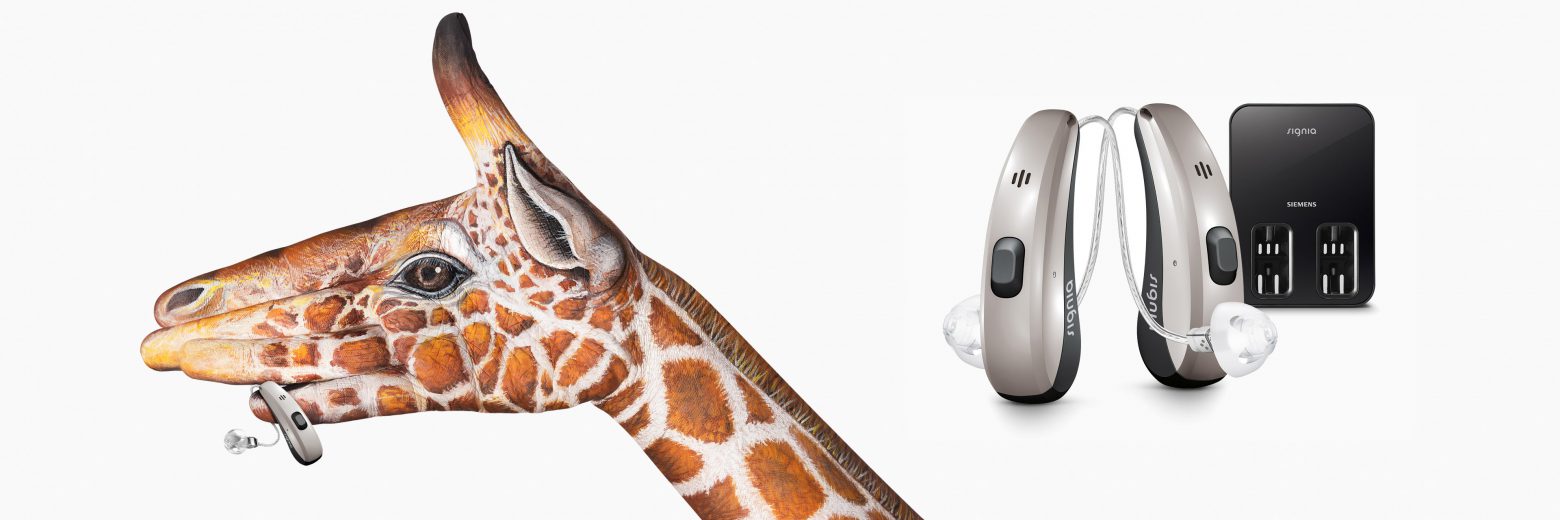What’s The Preferred Rechargeable Hearing Aid With Direct Streaming?
Aaron Jacobs, M.Aud B.Eng (Hons)

Combining new technologies together in a way which enhances user-benefit is an effective form of innovation. The Pure Charge&Go hearing aid follows this approach by integrating lithium-ion rechargeability and direct streaming in a receiver in the canal design. Despite the fact that lithium-ion modules are typically larger than disposable zinc-air batteries, the inductively charged lithium-ion technology allows a sealed design and the removal of space consuming components such as battery doors and charging contacts.
To test the appeal of Pure Charge&Go against leading competitor hearing aids, a study was conducted in the United States in April 2018, which was administered as an online survey. Participants were randomly selected and then screened for active smartphone use and hearing loss. The final participant group consisted of one-hundred people aged 40-70, with ninety-percent of the participants aged 50-70. Three-quarters of the participants wore hearing aids, and the majority of these participants were experienced hearing aid wearers (77 percent). At the time of writing, iOS provided the only direct streaming solution which supported binaural streaming of phone calls and of audio media. The study consequently focused on comparing iOS compatible direct streaming technology, and therefore the participant group was filtered to obtain a relatively high share (80 percent) of iOS smartphone users.
The study consisted of three parts: part one compared rechargeable hearing aids capable of direct streaming. In part two, rechargeable devices with lithium-ion technology were compared, even if the devices did not support direct streaming. Part three compared all of the devices from parts one and two, and used photos showing the size and design of each hearing aid. This was considered relevant because size is an important consideration during the hearing aid selection process.
The first and second parts used published manufacturer claims to compare various performance characteristics of each hearing aid. For example, information on battery runtime, time to full charge, rechargeable battery lifetime, and if the hearing aid was compatible with standard zinc-air batteries were given. Where necessary, the runtime values were adjusted to reflect five hours of streaming (a runtime based on five hours of streaming was provided in the marketing materials for all products except one).
For parts one and two, data was obtained to calculate the Net Promoter Score (NPS) by asking participants to answer the following question: How high would you rate the likelihood that you would recommend this product to a close friend? on a scale from 1 (very low) to 10 (very high). Based on these data, the NPS was calculated according to a standard definition by subtracting the detractor scores (participants who rated the product with a score in the range 1 to 6) from the promoter score (participants who rated the product with a score of 9 or 10). Scores of 7 or 8 were excluded from the NPS calculation (Reichheld, F. 2006). In addition, the match of the hearing aid to participants’ needs was investigated by asking participants to rate the following question on a scale from 1 (not sufficient) to 10 (perfectly): How well would this product meet your overall needs during everyday life?
Part three of the study compared all of the devices from parts one and two (Pure Charge&Go and two rechargeable hearing aids with direct streaming, and Pure Charge&Go with a lithium-ion hearing aid without direct streaming), and used photos which displayed the size and design of each hearing aid, in conjunction with facts describing key functionalities. As for parts one and two, the NPS was calculated. On all photos, the brand and name markings were removed from the hearing aids and accessories. For parts one, two and three, the order of presentation of the products was randomized between participants.
When more than two hearing aids were compared, a repeated measures Anova was calculated using Greenhouse-Geisser corrections. To identify differences between individual hearing aids Bonferroni post-hoc tests were used. In part two where only two hearing aids were compared, a paired T-test was performed.
Part One: Rechargeable Hearing Aids with Direct Streaming
For part one, the calculated NPS for the Pure Charge&Go was 12, while Products A and B yielded -19 and -21 respectively (see Fig. 1). In addition, a more detailed insight was obtained by using the raw data on this specific question (which included ratings of 7 and 8 that are ignored by the NPS calculation) to compare mean values. In a standard repeated measures Anova the results showed a significant difference between the recommendations for the three products (F(2;198)=15.29), p < 0.001). In a post-hoc analysis, the Pure Charge&Go was rated significantly higher than Product A (p < 0.05), and Product B (p < 0.05).

Data on match to wearers’ needs can be seen in Figure 2 where the percentage of respondents who rated the products positively (in the range 7 to 10) is displayed.
The entire data on this specific question was also analyzed (which included ratings from 1 to 10) to determine if a significant difference between mean values was evident (F(1.92;190.27)=19.38), p < 0.001). When differences between individual products were examined, the Charge&Go was rated significantly higher than Product A (p < 0.05) and Product B (p < 0.05).
Taken together, these results show that when participants based their ratings on various aspects of rechargeability performance, the majority of participants preferred Pure Charge&Go among the hearings aids compared. Pure Charge&Go was the only hearing aid in the group which used a lithium-ion cell, and could therefore deliver a longer runtime and shorter charging time compared to Products A and B which used silver-zinc rechargeable batteries.

Part Two: Lithium-ion Rechargeable Hearing Aids
Part two of the study examined two lithium-ion rechargeable hearing aids: Pure Charge&Go and Product C from a leading manufacturer. The participants were asked the same two questions as for part one. The results of the first question were used to determine the NPS, and the results of the second question were used to determine the positive match to respondents’ needs.
The calculated NPS was convincingly in favor of Pure Charge&Go with an NPS score of 23 versus 1 (see Fig. 3). The results of a two-tailed T-test using the raw data used to calculate the NPS (which included ratings of 7 and 8 that are ignored by the NPS calculation) showed a significant difference between Charge&Go and Product C (T(99)=2.57; p < 0.05).

Similarly, when the products were rated according to how positively the hearing aid met respondents’ needs, the Pure Charge&Go was rated slightly more favorably than the competitor lithium-ion rechargeable product (see Fig. 4).
While the Pure Charge&Go convincingly won the NPS comparison, the results were less clear for the question regarding positive match to needs. An analysis of the raw data (including all ratings from 1 to 10) showed a significant difference although the magnitude was relatively small (T(99) = 2.00; p < 0.05). It is worth noting that the positive match to needs scores for the lithium ion devices were relatively higher (81 for Charge&Go, and 70 for the other lithium-ion product), compared to the non lithium-ion rechargeable hearing aids from part one (products A and B had scores of 55 and 59 respectively). This suggests that wearers value the benefits arising from lithium-ion rechargeability to a greater extent than silver-zinc charging technology. The strong NPS result in part two indicated that for many participants, the Charge&Go was clearly the preferred device. This is probably because these participants considered direct streaming (which Product C did not offer) to have high importance.

Part Three: Visual Appearance and Key Functionality
In part three, where all hearing aids’ visual appearance were compared, Pure Charge&Go was the only product to achieve a positive NPS (see Fig. 5).
There were likely two factors which contributed to this result: the Charge&Go was the only direct streaming device which used an integrated rechargeable design. On the other hand, Products A and B were direct streaming hearing aids which used a third-party rechargeable solution which did not use a design integrated battery door. The second factor was that the competitor lithium-ion hearing aid required a body-worn accessory to be used for streaming. As for parts one and two, the significance of the raw data was tested (which included ratings of 7 and 8 that are ignored by the NPS calculation). A significant difference was found between the products (F(2.17;214.53)=14.24), p < 0.001). The results of the post-hoc test showed that the Signia product scored significantly higher than Product A (p < 0.05), Product B (p < 0.05), and Product C (p < 0.05).

Pure Charge&Go was the preferred hearing aid in all parts of the study: a comparison of rechargeable hearing aids featuring direct streaming, a comparison of lithium-ion rechargeable hearing aids, and a comparison of all devices which included photos showing size and design. In all parts, Pure Charge&Go consistently obtained a positive Net Promoter Score (NPS), whereas two out of three of the competitor products failed to obtain a positive NPS. In the comparison of rechargeable devices featuring direct streaming, Pure Charge&Go offered the most positive match to wearers’ needs among the hearing aids compared. In part three, where product size and visual design was included in the comparison, Pure Charge&Go remained the preferred device amongst the majority of participants.
Reichheld, F. (2006). The Ultimate Question: Driving Good Profits and True Growth. Brighton, MA: Harvard Business Review Press.

Aaron Jacobs worked as a clinical audiologist in Australia before starting at Sivantos Pty. Ltd. (formerly Siemens Hearing Instruments) as a product trainer. In 2010, Aaron relocated to Sivantos GmbH in Germany (formerly Siemens Audiologische Technik) where he was employed as a Software Product Manager. Since 2016, Aaron has worked in the Corporate Audiology department. Aaron holds a Bachelor of Mechanical Engineering (Honours) from RMIT University and a Master of Clinical Audiology from the University of Melbourne.